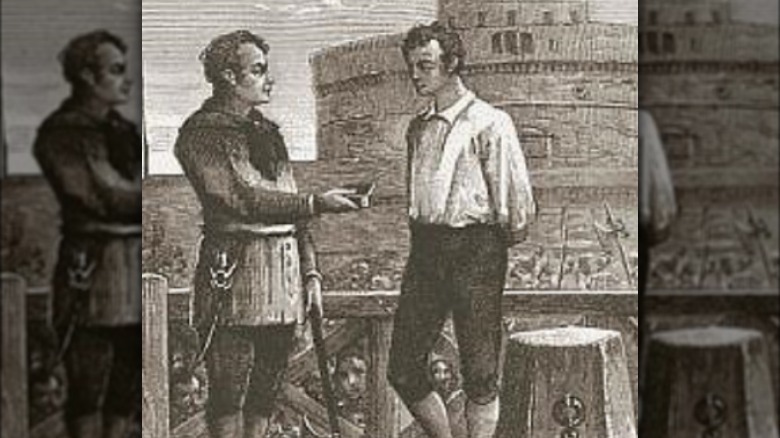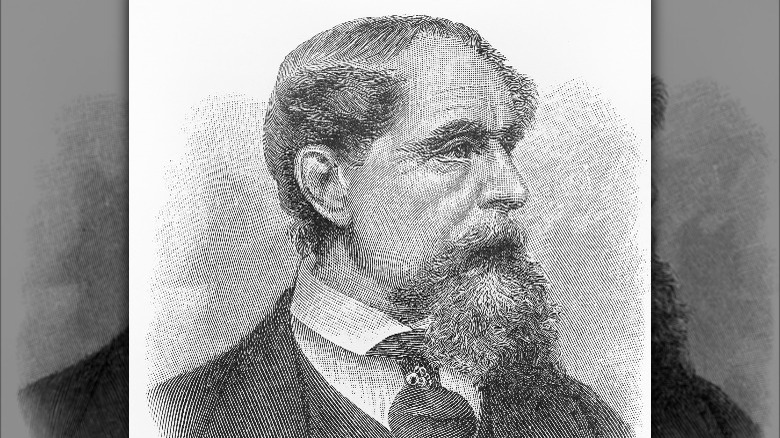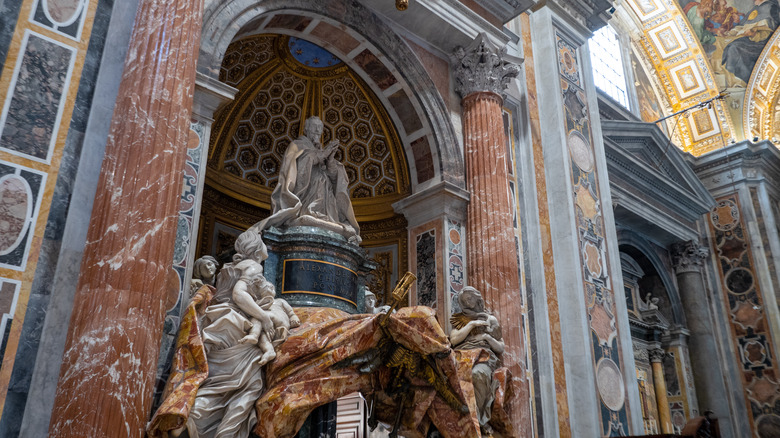The Truth About The Infamous 19th Century Roman Who Carried Out 514 Executions
The city of Rome is full of attractions that appeal to tourists from all over the world. The Colosseum, the Pantheon, St. Peter's Basilica, and the Trevi Fountain are just some of the most popular spots. If you're a fan of crime, however, one of the places you should visit in Rome is Museo Criminologico or the Crime Museum, which houses a collection of artifacts related to crime. On display at the museum behind a glass case are the ax and cloak that belonged to Mastro Titta, who was the official executioner for the Papal States.
The Papal States consisted of territories in Italy that were governed by the Pope, both in the spiritual and temporal sense. Public executions were common back then, and many people — including children — showed up to witness the executioner end someone's life (via Virtual Roma). From 1796 to 1864, the Papal States' official executioner was Mastro Titta, and he carried out 514 executions in that time frame.
Who was Mastro Titta?
Mastro Titta, or Master of Justice, was the nickname the people of Rome gave the Papal States' official executioner. He was a man named Giovanni Battista Bugatti, who performed his first execution when he was just 17 years old, as reported by Italy on This Day. How Bugatti was given the role of taking people's lives is not clear, but he did have another job that kept him busy when there was no scheduled execution.
Bugatti was said to be a burly man who worked as an umbrella painter and had a shop located next to his residence in Borgo Sant'Angelo on the western side of the Tiber River. According to Virtual Roma, Bugatti was not allowed to enter the city's main districts for his own security, as relatives of the people he had executed might retaliate against him. For that reason, Bugatti mainly kept to himself and his job until he was called on official business for an execution. When Bugatti crossed the bridge to get to the district, people immediately knew that an execution was about to take place.
Methods of execution
Giovanni Battista Bugatti carried out executions in different ways. The ax and the noose were the common methods of execution before the guillotine, which was invented to provide what was then deemed a more humane method of executing criminals (via History). The first recorded instance of the guillotine being used to execute someone was in April 1792 in France.
Apart from the aforementioned methods, Bugatti also claimed the lives of prisoners with more gruesome techniques for special cases. One technique was called the mazzatello, wherein Bugatti welded a large mallet that he smashed over the head, as reported by the National Catholic Reporter. Afterward, the throat is slashed to ensure that the criminal was dead. Another method was called drawing and quartering. Each of the prisoner's hands and feet is tied to a horse, and the four horses would then be spurred. The prisoner's body is then stretched in different directions. These two methods were reserved for those who have committed the vilest criminal acts.
Charles Dickens witnessed an execution by Mastro Titta
In 1846, a travel journal written by English writer Charles Dickens titled "Pictures from Italy" was published. Dickes took a hiatus from writing books in 1844, and he traveled to various locations in Italy and France with his family. In his journal, Dickens wrote about witnessing the beheading of a criminal in Rome, and the act was carried out by none other than Giovanni Battista Bugatti (per Charles Dickens Page).
Dickens headed to the location of the execution accompanied by two of his friends, and they waited for hours before the execution took place. Mastro Titta used the guillotine for the execution, and the writer described how it happened. The prisoner knelt down and had his head secured into a whole. All of a sudden, the guillotine's plank descended, and the prisoner's head fell into a bag. Bugatti then held the decapitated head by the hair and showed it to the crowd. Dickens wrote, "It was an ugly, filthy, careless, sickening spectacle."
Giovanni Battista Bugatti did his job well
According to reports, Giovanni Battista Bugatti did his job as an executioner well, and that was because of his detachment from the act. Per Virtual Roma, the trait is common to Romans who have to go through challenges in life. By all accounts, Bugatti didn't enjoy his job as an executioner, but it was a task that someone had to do. There were records of Mastro Titta offering prisoners tobacco or conversing with them before he executed them as well.
Bugatti took note of all the executions he performed in a journal, which included the names of the prisoners, their charges, their last words, and how he killed them (via Italy's Wonders). He was the official executioner of the Papal States for more than six decades before he retired at 85 years old in August 1864. It is said that even in his old age, Bugatti was still strong and was able to do his job well. He was replaced by Vincenzo Balducci after his retirement.
The church and death penalty
Giovanni Battista Bugatti remains one of the most famous executioners in the world. After his retirement, his successors took on the nickname Mastro Titta and it has been synonymous with being an executioner. The last execution in the Papal States took place in 1870, according to Executed Today. It's quite difficult to fathom how the Pope carried out death sentences for criminals, but they were done to set an example, and it was a way to let the people witness what would happen to them if they committed crimes.
However, the death penalty was more than a form of punishment. Per the National Catholic Reporter, executions were rituals with a theological aspect. People were asked to pray for the souls of the prisoners, and the Pope would pray for those condemned as well. Before the execution, executioners were visited by a priest for confession, and they also had communion, which is a symbol that the act they were about to perform was sanctioned by the church. Mastro Titta remains notorious, and his work has been immortalized in poems, plays, and stories about him.





